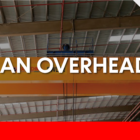In the realm of material handling and lifting solutions, jib cranes stand out as versatile and efficient machines. These compact yet powerful devices play a crucial role in various industries, offering a range of applications from small workshops to large manufacturing facilities. In this exploration, we will delve into what jib cranes are, the different types available, their key components, and the diverse ways in which they are employed across industries.
What is a Jib Crane?: A Snippet
A jib crane is a type of material handling equipment designed for lifting and moving heavy loads within a specific work area. Characterized by its horizontal arm, known as a jib or boom, the crane is typically mounted on a vertical support structure, which can be a freestanding pillar, a wall-mounted bracket, or a vertical mast. The distinguishing feature of a jib crane is its ability to rotate horizontally, providing a full 360-degree range of motion. This design allows for precise load positioning and facilitates efficient material handling in various industrial and commercial settings.
Components of a Jib Crane:
Jib/Boom: The horizontal arm extending from the vertical support structure. It varies in length depending on the specific application and lifting requirements.
Pillar or Mast: The vertical support structure that provides stability to the crane. The type of support (freestanding, wall-mounted, or mast) depends on the crane’s design and intended use.
Hoist or Trolley: The lifting mechanism that moves along the jib to lift and lower the load. The hoist is equipped with a motor, cables, and lifting attachments such as hooks, magnets, or grabs.
Rotation Mechanism: A system that allows the jib crane to rotate horizontally. Depending on the crane type, the rotation can be achieved manually or through a motorized system for increased efficiency.
Foundation: The base or mounting structure that supports the crane and ensures stability during lifting operations. The foundation is a critical component for maintaining balance and preventing tipping.
A Detail Insight on the Types of Jib Cranes
Jib cranes come in various types, each designed to meet specific lifting needs and operational requirements. The diversity in jib crane types allows businesses to choose the most suitable configuration based on factors such as available space, load capacity, and the nature of the lifting tasks. Let’s explore some common types of jib cranes in more detail:
Free-Standing Jib Crane:
A free-standing jib crane is mounted on a dedicated vertical support pillar that is separate from any existing structures. This type of jib crane offers 360-degree rotation, providing versatility in load positioning.
Advantages:
– Ideal for areas with ample floor space.
– Offers maximum coverage within the designated workspace.
– Can be easily installed without the need for existing structures.
Wall-Mounted Jib Crane:
Wall-mounted jib cranes are attached to a vertical structure, such as a wall or column. They provide efficient lifting and maneuverability along the wall, making them suitable for areas with limited floor space.
Advantages:
– Space-saving design, perfect for confined workspaces.
– Allows for precise load positioning along the wall.
– Easy installation on existing structures.
Articulating Jib Crane:
An articulating jib crane features a rotating arm with an additional hinge joint, providing an increased range of motion. This type is particularly useful in confined spaces or when a high level of precision is required.
Advantages:
– Enhanced flexibility for precise load positioning.
– Suitable for tasks that involve reaching around obstacles.
– Excellent for applications with limited headroom.
Mast-Type Jib Crane:
Mast-type jib cranes utilize a vertical mast to support the horizontal boom. This configuration offers increased height and reach compared to other types, making it suitable for outdoor settings or locations with high ceilings.
Advantages:
– Provides additional height for lifting tasks.
– Suitable for open spaces where a vertical mast can be accommodated.
– Ideal for applications requiring extended reach.
Articulating Arm Jib Crane:
Articulating arm jib cranes have a multi-jointed arm that can extend, retract, and articulate, providing a wide range of motion. This type is highly versatile and adaptable to various lifting scenarios.
Advantages:
– Offers flexibility in reaching into confined or awkward spaces.
– Can be adjusted to different angles and lengths.
– Well-suited for tasks that require precise and dynamic load positioning.
Portable Jib Crane:
Portable jib cranes are designed for mobility, allowing them to be easily moved to different locations within a facility. These cranes often feature wheels or casters for convenient transportation.
Advantages:
– Provides flexibility in adapting to changing work environments.
– Suitable for temporary lifting tasks.
– Easy to relocate as needed.
Column-Mounted Jib Crane:
Column-mounted jib cranes are attached to a vertical column or post, providing a fixed point for rotation. This type is commonly used in areas where a freestanding pillar is not practical.
Advantages:
– Requires minimal floor space for installation.
– Offers 360-degree rotation for versatile load handling.
– Can be integrated into existing structures.
Foundationless Jib Crane:
Foundationless jib cranes are designed to be installed without the need for a dedicated foundation. They are anchored directly to the existing floor, simplifying the installation process.
Advantages:
– Cost-effective as it eliminates the need for extensive foundation work.
– Allows for quicker installation and setup.
– Suitable for facilities with floor space constraints.
How Jib Cranes Work:
Jib cranes operate by utilizing their horizontal arm to lift and move loads within a designated area. The hoist, attached to the trolley, travels along the jib, allowing for vertical movement of the load. The rotation mechanism enables the crane to turn horizontally, providing the flexibility to position the load precisely. The operator, either manually or using a control system, can manipulate the crane to lift, lower, and transport heavy materials with ease.
Applications of Jib Cranes:
Workshop and Manufacturing:
– Lifting and moving materials within a workshop or manufacturing facility.
– Efficient for tasks such as assembly, welding, and machining.
Construction Sites:
– On-site lifting solutions for construction projects.
– Facilitates the movement of construction materials and equipment.
Loading Docks:
– Loading and unloading goods from trucks and containers.
– Provides flexibility in positioning heavy loads for efficient logistics.
Maintenance and Repair:
– Lifting and positioning heavy equipment or components during maintenance tasks.
– Enables technicians to work on machinery with precision.
Warehousing:
– Optimizes space utilization in warehouses for lifting and moving goods.
– Enhances efficiency in storage and retrieval operations.
Advantages of Jib Cranes:
Jib cranes offer a multitude of advantages that make them a popular choice for material handling and lifting tasks in various industries. These advantages contribute to increased efficiency, safety, and flexibility in the workplace. Let’s delve into the expanded details of the key advantages of jib cranes:
Space Efficiency: Jib cranes are known for their compact design, making them particularly suitable for facilities with limited space. Whether mounted on a freestanding pillar, attached to a wall, or integrated into existing structures, jib cranes optimize the use of available floor space. Their ability to provide 360-degree rotation allows for efficient coverage within a designated work area without requiring extensive room for operation.
Cost-Effectiveness: Jib cranes are generally more cost-effective than larger lifting systems or overhead cranes. The reduced size and simpler design contribute to lower installation and maintenance costs. Additionally, their modular construction allows for easier customization, making them an economical choice for businesses looking to enhance their material handling capabilities without breaking the budget.
Versatility in Load Positioning: The rotating arm of a jib crane enables precise load positioning in any direction within its operational radius. This versatility is crucial for various lifting tasks, especially in manufacturing, construction, and maintenance applications. Operators have the flexibility to reach specific points without repositioning the crane, increasing overall efficiency and reducing the time required for material handling.
Ease of Installation: Jib cranes are relatively easy to install compared to larger lifting systems. Freestanding jib cranes, in particular, require minimal foundation work, simplifying the installation process. Wall-mounted and column-mounted jib cranes leverage existing structures, further reducing the complexity of setup. This ease of installation translates to shorter downtimes and quicker integration into the workflow.
Improved Safety: Jib cranes contribute to enhanced workplace safety in multiple ways. The precise control they offer during load positioning minimizes the risk of accidents, reducing the potential for damage to materials and equipment. Additionally, jib cranes are equipped with safety features such as limit switches, emergency stop buttons, and overload protection systems, further ensuring the well-being of operators and preventing equipment damage.
Flexibility in Applications: Jib cranes find applications across a wide range of industries, including manufacturing, construction, warehouses, and maintenance. Their versatility makes them suitable for lifting and moving various materials, from heavy machinery and components to pallets and tools. The ability to adapt to different tasks makes jib cranes a valuable asset in dynamic work environments.
Reduction in Manual Handling: By providing a reliable and efficient means of lifting and moving heavy loads, jib cranes significantly reduce the need for manual handling. This not only minimizes the risk of musculoskeletal injuries to workers but also improves overall productivity by automating repetitive and physically demanding tasks.
Adaptability to Different Environments: Jib cranes come in portable and foundationless configurations, allowing them to be easily moved or adapted to different work environments. Portable jib cranes, equipped with wheels or casters, are particularly adaptable and can be relocated as needed. This adaptability makes jib cranes suitable for temporary workstations or facilities with changing layouts.
Quick and Precise Load Response: Jib cranes, especially those with modern control systems, provide quick and precise responses to operator commands. This responsiveness is crucial for applications that require accurate load positioning or for tasks that demand immediate adjustments. The ability to swiftly respond to changing conditions enhances the efficiency and safety of material handling operations.
Enhanced Productivity: Overall, the advantages of jib cranes contribute to increased productivity in the workplace. With efficient load positioning, reduced manual handling, and quick response times, jib cranes streamline material handling processes. This efficiency results in faster task completion, reduced downtime, and improved overall workflow productivity.
Final Words
Wrap up, a jib crane is a valuable addition to industrial and commercial settings, providing efficient and flexible solutions for material handling. Understanding the components, types, and applications of jib cranes empowers businesses to make informed decisions about integrating these powerful machines into their operations, ultimately improving productivity and safety.



